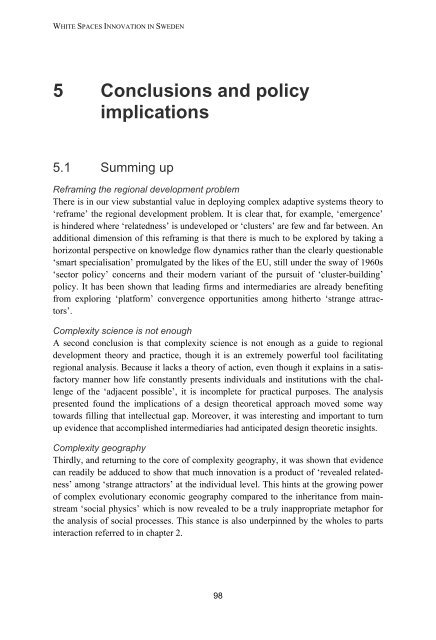White Spaces Innovation in Sweden - Innovation policy for ... - Vinnova
White Spaces Innovation in Sweden - Innovation policy for ... - Vinnova
White Spaces Innovation in Sweden - Innovation policy for ... - Vinnova
You also want an ePaper? Increase the reach of your titles
YUMPU automatically turns print PDFs into web optimized ePapers that Google loves.
WHITE SPACES INNOVATION IN SWEDEN5 Conclusions and <strong>policy</strong>implications5.1 Summ<strong>in</strong>g upRefram<strong>in</strong>g the regional development problemThere is <strong>in</strong> our view substantial value <strong>in</strong> deploy<strong>in</strong>g complex adaptive systems theory to„reframe‟ the regional development problem. It is clear that, <strong>for</strong> example, „emergence‟is h<strong>in</strong>dered where „relatedness‟ is undeveloped or „clusters‟ are few and far between. Anadditional dimension of this refram<strong>in</strong>g is that there is much to be explored by tak<strong>in</strong>g ahorizontal perspective on knowledge flow dynamics rather than the clearly questionable„smart specialisation‟ promulgated by the likes of the EU, still under the sway of 1960s„sector <strong>policy</strong>‟ concerns and their modern variant of the pursuit of „cluster-build<strong>in</strong>g‟<strong>policy</strong>. It has been shown that lead<strong>in</strong>g firms and <strong>in</strong>termediaries are already benefit<strong>in</strong>gfrom explor<strong>in</strong>g „plat<strong>for</strong>m‟ convergence opportunities among hitherto „strange attractors‟.Complexity science is not enoughA second conclusion is that complexity science is not enough as a guide to regionaldevelopment theory and practice, though it is an extremely powerful tool facilitat<strong>in</strong>gregional analysis. Because it lacks a theory of action, even though it expla<strong>in</strong>s <strong>in</strong> a satisfactorymanner how life constantly presents <strong>in</strong>dividuals and <strong>in</strong>stitutions with the challengeof the „adjacent possible‟, it is <strong>in</strong>complete <strong>for</strong> practical purposes. The analysispresented found the implications of a design theoretical approach moved some waytowards fill<strong>in</strong>g that <strong>in</strong>tellectual gap. Moreover, it was <strong>in</strong>terest<strong>in</strong>g and important to turnup evidence that accomplished <strong>in</strong>termediaries had anticipated design theoretic <strong>in</strong>sights.Complexity geographyThirdly, and return<strong>in</strong>g to the core of complexity geography, it was shown that evidencecan readily be adduced to show that much <strong>in</strong>novation is a product of „revealed relatedness‟among „strange attractors‟ at the <strong>in</strong>dividual level. This h<strong>in</strong>ts at the grow<strong>in</strong>g powerof complex evolutionary economic geography compared to the <strong>in</strong>heritance from ma<strong>in</strong>stream„social physics‟ which is now revealed to be a truly <strong>in</strong>appropriate metaphor <strong>for</strong>the analysis of social processes. This stance is also underp<strong>in</strong>ned by the wholes to parts<strong>in</strong>teraction referred to <strong>in</strong> chapter 2.98
















